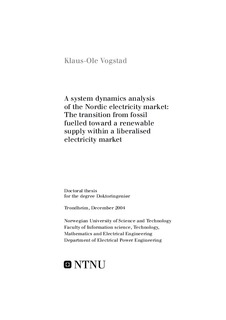| dc.description.abstract | A system dynamic model to analyse long-term versus short-term implications of various energy policies within the context of the Nordic electricity market has been developed. The model itself provides a theory of the development of the Nordic electricity market in response to various energy policies, both in the long and the short term. The model includes generation scheduling, demand, price formation, investment decisions, resource availability and to some extent technology progress as endogenous. Thus, explanations of the model behaviour can be found from within the model.
As examples of use, the model/modeling concept addresses two important questions on the energy policy agenda. First the marginal CO2-emission controversy has been study, whether building gas power in Norway increase or reduce Nordic CO2-emissions. The results were that in the short run, some emission reductions can be obtained due to substitution of existing coal units by operations of the market, but this effect was found to be modest. Existing gas power is also substituted, plus some bio.
In the long run, there are also some investment substitutions of renewables. These effects do not appear to be significant in the short run, but in the long run, the investment rate of renewables are reduced as a consequence of reduced prices from gas. The reduced investments in renewables results in increased emissions.
Some increase in demand is also to be expected from adding gas power, due to price elasticiy of demand. The net result is that gas power is likely to increase CO2-emissions, which contradicts the current belief as well as results from other electricity market models that omit the long-term mechanisms such as investment decisions and technology progress.
The second study analysed the current Swedish TGC market at the time of the introduction. The purpose was to assist market design. It was found that the current Swedish TGC market design is likely to crash, due to the slow adjustment of the supply side, plus the possibility for banking that enable suppliers to withhold certificates and increase prices. This problem can be avoided by allowing borrowing. Furthermore, the combination of system dynamics and experimental economics was conducted and tested. Combining simulation with laboratory experiments is now gaining momentum within power engineering and liberalisation of markets. The experimental approach can play an important role in the design of market mechanisms that will ensure robust and well working markets.
Finally, a stochastic dynamic optimisation model for hydro scheduling in combination with wind power was developed. The model is based on the water value method, and contains the principal mechanisms of existing hydro scheduling models. This simplified model allowed for a range of studies on how the complementaries of wind will influence the optimal hydro schedule. In particular the hypothesis that wind power reduces the need for reservoirs has been tested, and the results show that economic benefits can be obtained by including wind in hydro scheduling. | nb_NO |

